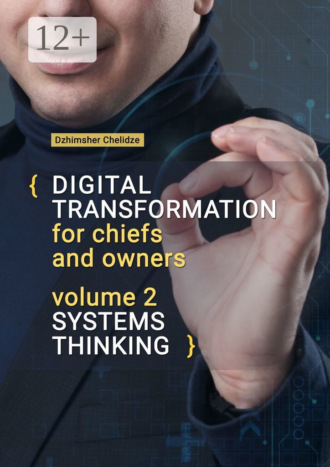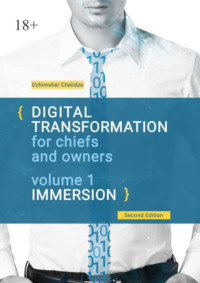
Полная версия
Digital transformation for chiefs and owners. Volume 2. Systems thinking
– Next, we will look at all the basic standards that underlie all approaches. This may seem superfluous to you as leaders, but through understanding the tools you will be able to choose the right one. Additionally, for the executives of large companies, this will allow more effective management of the team and not collect bullshit, which is often tried to hang particularly smart managers.
Project implementation methodology
PMBOK
PMBOK (Project Management Body of Knowledge). In Russian, it is a «collection of knowledge about project management». Process classifier (until 2021), which says that and when to execute in order for the project to achieve its stated goals.
This code is the result of Americans’ work in their desire to create a universal instruction manual. They wanted to move away from the human factor in management and to ensure that anyone who took this instruction could implement the project. The PMI (Project Management Institute – Institute of Project Management) certifies the volume.
PMI also issues a PMP (Project Management Professional) certificate. Additionally, it’s the certificates that this organization wants to see from project managers in big corporations.
PMBOK is the most common methodology that can be used in most projects.
This approach was the first to introduce the concept of a «project triangle» which describes the balance between cost, time and quality of the project.

Project triangle
At the same time, the sixth version of PMBOK is still valid, but in 2021 the seventh version was released. It is moving to a more flexible management. The standard no longer says what to do and when, but gives tools and clues, encouraging managers to define their own actions.
This was a response to the uncertainty and instability of the modern so-called VUCA-world:
– Volatility (instability) – constant changes in the environment, customer requests.
– Uncertainty (uncertainty) is almost impossible to predict and plan. Now strategic planning covers not 3-5-10 years, but 1—2 years. This is the consequence of political conflicts, wars, epidemics.
– Complexity (complexity) – factors that have to be considered, becomes more and more. Hence, by the way, such hopes for support and decision-making systems based on artificial intelligence.
– Ambiguity (ambiguity) – the information that guides us in making decisions has more than one meaning and one interpretation, it is impossible to be sure that black is black and white is white. Factors that can change meaning drastically are constantly revealed.
However, in the world agenda since about 2016 there was a new acronym – BANI:
– Brittle (fragile) – any system breaks down easily and quickly.
– Anxious (disturbing) is a constant change that cannot be managed and must be constantly adjusted by breaking your plans.
– Nonlinear (non-linear) – the same actions lead to different results.
– Incomprehensible (incomprehensible) – the inability to navigate the infinite stream of contradictory information.
As you can see, it is, in fact, about the same thing, so you should not be afraid of these names. The answer to these concepts – flexibility, the way of careful trial and error.
Back to our topic, PMBOK. My personal opinion is that simplification in the new version is dangerous. If we look at the situational model of leadership (we will talk about it later), this approach is relevant for companies where there is already experience of project management. If we are talking about young companies without any competencies, they need clear and prescriptive instructions. I see the same dependency in my practice: the lower level of competence of clients, the more they want you to lead them by the hand, and better – did everything yourself. Even if you could describe how things work, what are the mechanisms and the tools, for them the most valuable algorithm: take a stick, go to the palm tree, hit a banana. And that’s why I’ve come to realize that for a fundamental change in project management, you need a digital advisor who will tell you what to do, how to do it, and teach you in parallel to form competences.
So let’s take a closer look at the current sixth version. It implies the following groups of processes:
– initiation;
– planning;
– execution;
– monitoring and control;
– completion.
In general, these groups of processes need to be remembered as 14 Toyota DAO, because every project goes through these stages. Additionally, within each group, there are the same groups of processes. This is the matrix. On this basis, the main stages of the project appear: initiation, planning, implementation and control, closure. The initial stages are the least costly but most important.

Project phases and resource requirements
Under each stage, certain processes must be performed.
The most frequent causes of problems are the unprocessed stages of initiation and planning. There are no clear criteria for success, no defined risks, communication. They’re responsible for most of the 70 percent of bad and bad projects. In the current uncertainties, it is crucial to invest 20—30% in force majeure (the main postulate of risk management) at the planning stage, and a number of IT practitioners generally believe that up to 50%.
However, the above-mentioned groups of processes are not strictly linked to the project phases. There are initiation processes at the project closure stage (initiation of closure, document collection, etc.)
Additionally, PMBOK implies management:
– By integration.
Decisions on resource concentration; attempts to anticipate potential problems and resolve them before they become critical; coordination of project work. Through integration, trade-offs can be made between overlapping goals and alternatives.
– Content.
For example, creating a hierarchical structure for project work, defining, planning, validation and content management.
– Terms.
Definition of the composition of operations and their interrelationships, assessment of resources and duration of operations, development and management of the timetable.
– Value.
Budget development and cost control. Cost estimation, development of the budget, cost management.
– By Quality.
All processes related to achieving objectives. These include planning, quality assurance and quality control.
– By Human Resources.
Organization and management of the project team. Planning of human resources, recruitment and development of the team.
– By Communications.
Communication is planned, information is disseminated, performance reporting is created, project participants are managed.
– Risks.
The processes involved are risk management planning, identification, qualitative and quantitative risk analysis, response planning, monitoring and risk management.
– By Supply.
Planning of purchases and contracts, solicitation of information from suppliers, selection of suppliers, administration and closing of contracts.
Summary
Personally, I emphasise communication and people management, supplier, customer and integration. Through this we are more likely to learn about the risks, possible problems with quality or timing, counterparties. It helped me to implement projects in different industries and with different people. Even when I had no idea about project management.
Communication problems are also causing problems in project implementation. Too much emphasis on formal tools will not save you from problems, but rather build barriers to communication.
If we talk about the approach, I would recommend young companies to start with the sixth version, a little bit grow «mentally», and then move on to the seventh version of the standard. Or find a consultant who will help you to go through the way of building a design culture on the seventh version of the standard. It’s a question of resources – time and money – what you have more.
Конец ознакомительного фрагмента.
Текст предоставлен ООО «Литрес».
Прочитайте эту книгу целиком, купив полную легальную версию на Литрес.
Безопасно оплатить книгу можно банковской картой Visa, MasterCard, Maestro, со счета мобильного телефона, с платежного терминала, в салоне МТС или Связной, через PayPal, WebMoney, Яндекс.Деньги, QIWI Кошелек, бонусными картами или другим удобным Вам способом.






